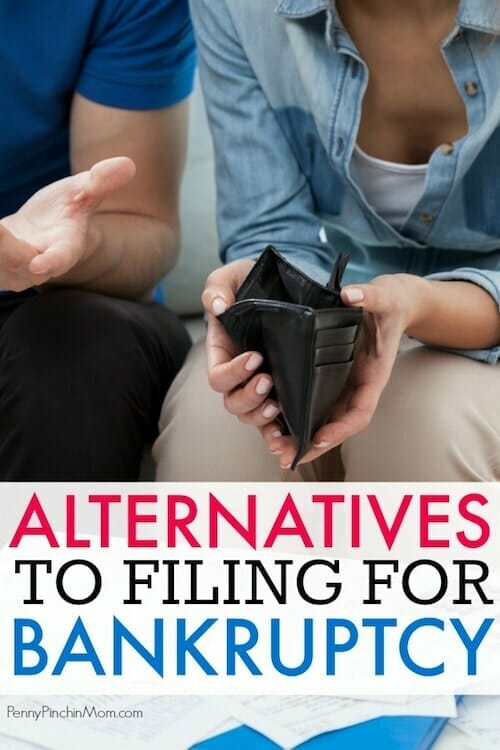The biggest obstacle to someone with a crushing debt burden is a lack of knowledge of how to get their arms entirely around the problem, and know how to go about making it right.
They do not understand what options are available to them, and if they do, they are unsure as to what the right first step for them is. While many think bankruptcy is the answer, some alternatives may work better.
I can relate to the soul-crushing feeling of debt. I declared bankruptcy in 2010. While it wasn’t my finest moment, I was able to learn from my mistakes and now live the financial life I want. But, it wasn’t easy. I had issues with my credit for years, and it followed me everywhere I went.
Had I known about some of these bankruptcy alternatives, I could have saved myself a lot of headaches. Take the time to research your options before you pick up the phone to call an attorney.
HOW TO AVOID FILING FOR BANKRUPTCY
Debt Management Programs
Debt management programs, also called debt consolidation programs or credit counseling, is a way for people to pay off their unsecured debt using a third party debt relief company. A debt management program (DMP) works like this:
- Customer enrolls in a DMP with a debt relief company providing them with information regarding the accounts to include in the program.
- The debt relief provider negotiates a monthly payment and reduced interest rate with the creditor that results in the elimination of the debt in 3-5 years.
- The customer makes a single payment to the debt relief provider, including a monthly administration fee based upon the amount of debt enrolled in the program. This fee usually ranges between $10 and $50 per month. The debt relief provider then disperses the agreed upon payment amounts to each creditor.
- In exchange for a fixed monthly payment and reduced interest rate, creditors close the accounts so that you do not accumulate additional debt. While the act of enrolling in a debt management program does not affect your credit score, the closing of accounts will affect your debt to income ratio, as well as your credit history likely causing your credit score to dip in the beginning. However, by making consistent payments to the DMP, as well as to other financial commitments, a customer’s credit score usually rebounds quickly.
DMPs generally work well for people who are current with their payments but cannot make any progress on the balances due to high interest rates. By closing the accounts to avoid future debt, and having negotiated monthly payment and lowered interest rate, DMP customers can repay their unsecured debt within 3-5 years.
Debt Settlement Programs
A Debt Settlement Program (DSP) involves legal representation and for people who have a dier financial situation, but who still would like to try to avoid bankruptcy. People who enroll in a DSP go through the following process:
- Customers stop paying the creditors enrolled in the program
- Customers make monthly payments to the debt relief provider to fund an escrow account.
- Over time, the customer’s accounts become severely delinquent. The lawyer assigned to the account will then reach out to creditors to negotiate a settlement of the account for less than the full amount.
- The agreed-upon settlement is paid from the escrow account.
Debt settlement will have an adverse effect on a customer’s credit score since payments to the creditors are halted. Customers may also begin to receive collection calls from the creditor, at which time they are to inform the caller of the legal representation now handling the account. By law, this should stop the phone calls. There may also be tax implications for the amount of debt forgiven through a DSP.
DSPs are generally used by people who cannot meet all their monthly financial commitments and need to lower their monthly payments but want to avoid bankruptcy. By having the debt relief provider negotiate a settlement of less than the amount owed, customers can make progress on getting creditors off their backs in 3-5 years and then focus on rebuilding their financial future.
Negotiate directly with your creditors
Your creditor would much rather work with you than deal with bankruptcy. If you have assets you can liquidate and use to pay down the debt, they may be willing to accept a lower amount. Reach out and talk to your creditors to negotiate rates or even the balances to a more manageable amount.
If your creditors are harassing you, that is illegal and you can stop it. Read more about how to stop collectors from calling you.
Just Keep Trying
If you are getting by and your budget works, there may not be a reason to give bankruptcy much thought. Instead, work to create a debt repayment plan you can follow. It may mean getting a second job or selling items, but there are many ways you can come up with more money to throw at your debt
The worst thing that will happen is your credit score will drop. But, if you aren’t trying to get new credit for any reason, I would not stress about it in the short term. Once your debt is paid down, you can do many things to increase your score quickly.
Debt consolidation
Check with your lender to see if there is a way you can consolidate your debts into a more manageable payment. You usually need to provide collateral, such as your vehicle. Alternatively, you might be able to tap into the equity in your home by getting a new mortgage for the balance owed PLUS the equity (where you can use the equity to pay off your loans).
If you’ve tried everything, but can’t see any other way but bankruptcy, make sure you know what you are getting into before you file. It affects you and your family.

